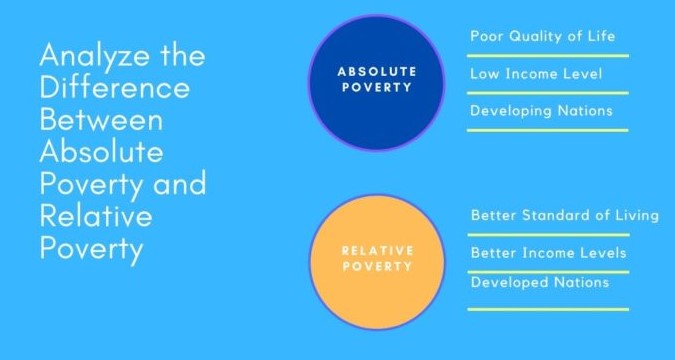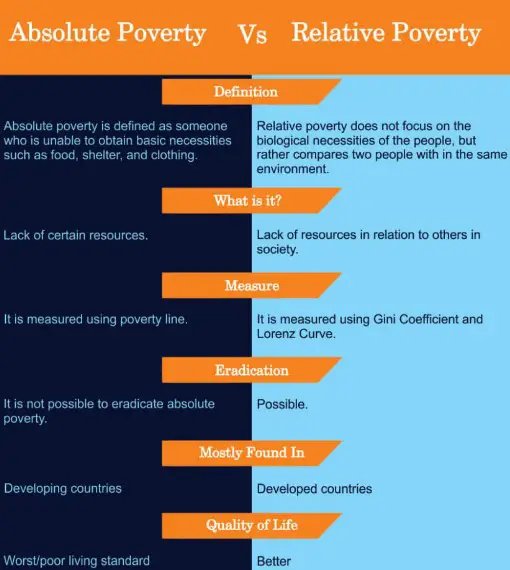Poverty affects people all over the world, but not all poverty is the same. In this blog, we will explore the differences between absolute poverty and relative poverty, two terms often used to describe the financial hardship of individuals and families.
We will look at what constitutes each type of poverty and why it is important to distinguish between the two.
Comparing the definitions of absolute and relative poverty

Absolute poverty and relative poverty are two terms that are often used to describe the economic condition of individuals and households. The distinction between the two lies in the measure used to define them.
Absolute poverty is defined by the absolute lack of resources needed to sustain even the most basic standard of living, while relative poverty is determined by the gap between a person or household’s financial resources and the resources of the rest of society. In other words, relative poverty considers the resources available to the average person or family in a given society and individuals or households who fall below this average are considered to be in relative poverty.
Examining the causes of absolute and relative poverty
Absolute poverty and relative poverty are two different types of poverty that have different causes and effects. Absolute poverty refers to a lack of basic human needs, such as food, clothing, and shelter.
Relative poverty, on the other hand, is defined by an individual or household’s income level when compared to the average income of other people in their society. Absolute poverty is often caused by economic and environmental factors, such as natural disasters, conflict, lack of access to resources, and inadequate infrastructure or access to education. Relative poverty is often caused by income inequality, unemployment, and social exclusion.
Both types of poverty can have devastating effects on individuals and communities, including poor health, inequality, and decreased access to education and other resources.
Understanding the impact of absolute and relative poverty
The difference between absolute poverty and relative poverty can be boiled down to a simple concept: the measure of one’s economic well-being relative to the average of other people in society. Absolute poverty is the minimum level of income necessary to meet basic needs such as food, shelter, clothing, and other basic necessities. Relative poverty is defined as an income level below the average for the population in which an individual resides.
Relative poverty is defined as an income level below the average for the population in which an individual resides. This means that a person in absolute poverty may have just enough money to survive, while a person in relative poverty may be able to afford more, but is still below the average of their peers. Both types of poverty can have an impact on a person’s quality of life, but understanding the difference between the two can help us better understand the effects of poverty on individuals and communities.
Strategies to reduce absolute and relative poverty
Absolute poverty and relative poverty are two distinct concepts that are used to describe the economic condition of individuals and households. Absolute poverty is a condition where an individual or household lacks the basic necessities of life, such as food, shelter, and clothing. Relative poverty is a condition where an individual or household does not have the same level of income or resources as others in the same society.
In other words, relative poverty is a relative measure of poverty in comparison to the overall economic condition of the society. When it comes to reducing poverty, there are a number of strategies that can be employed to reduce both absolute and relative poverty.
These include increasing access to education, providing job opportunities, providing access to health care, and providing access to financial services. Additionally, governments can increase the minimum wage, implement targeted social programs, and provide economic incentives to encourage businesses to invest in poorer communities.
Resources for further learning about absolute and relative poverty

Absolute poverty and relative poverty are two different ways of measuring economic hardship. Absolute poverty measures the number of people living below a certain income threshold, whereas relative poverty measures the level of income inequality within a society. Generally, absolute poverty is considered to be a lack of basic needs such as food, shelter, and clothing, while relative poverty is a comparison to the overall economic prosperity in a society.
To put it simply, absolute poverty is a measure of how much an individual has while relative poverty is a measure of how much a person lacks compared to those in the same society. Understanding the difference between the two is important in order to develop effective policies that address both types of poverty.
Conclusion
In conclusion, the key difference between absolute poverty and relative poverty lies in the fact that absolute poverty is defined in terms of a fixed amount of money and relative poverty is determined by comparing an individual’s or household’s income to the average income of a population. Absolute poverty is a more extreme form of poverty, as it measures an individual’s or household’s inability to meet basic needs, such as food, water, and shelter.
Both forms of poverty are serious issues that require attention in order to reduce poverty levels and improve the quality of life for all.

